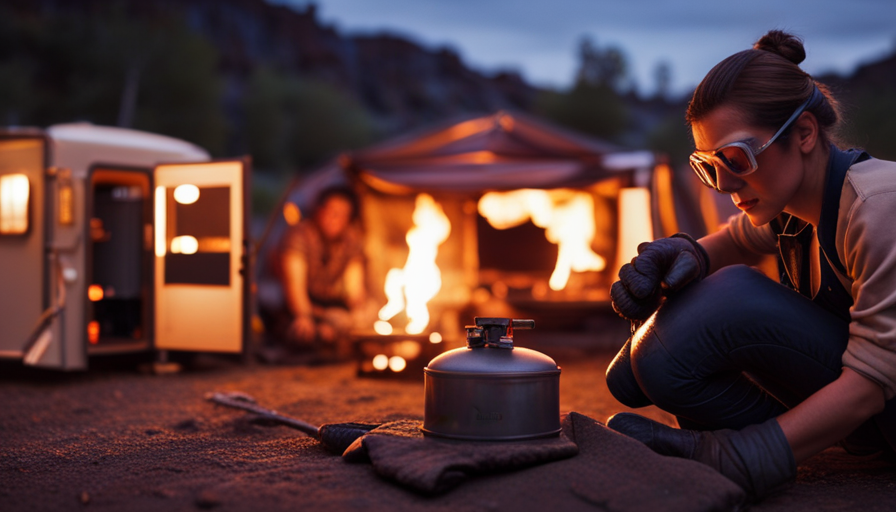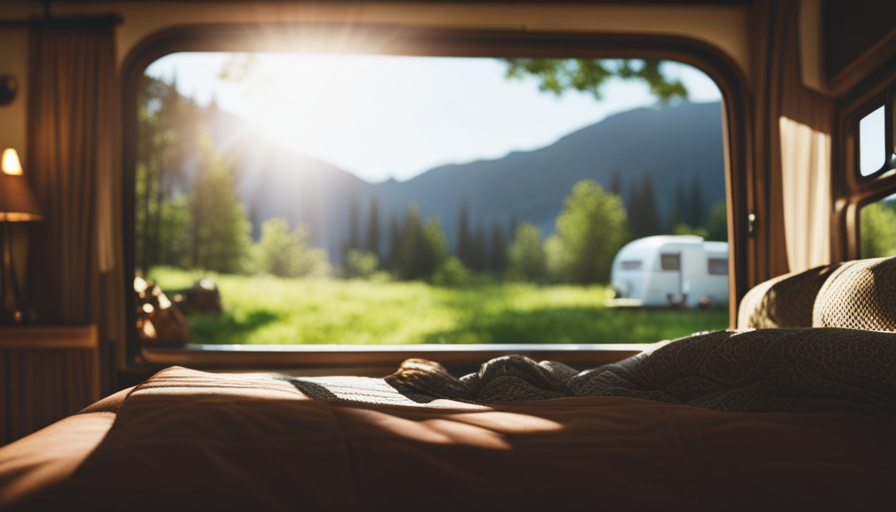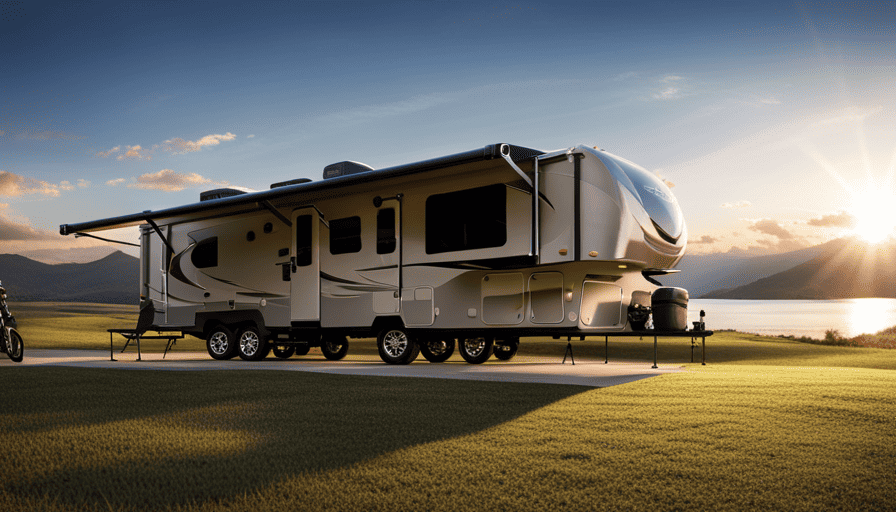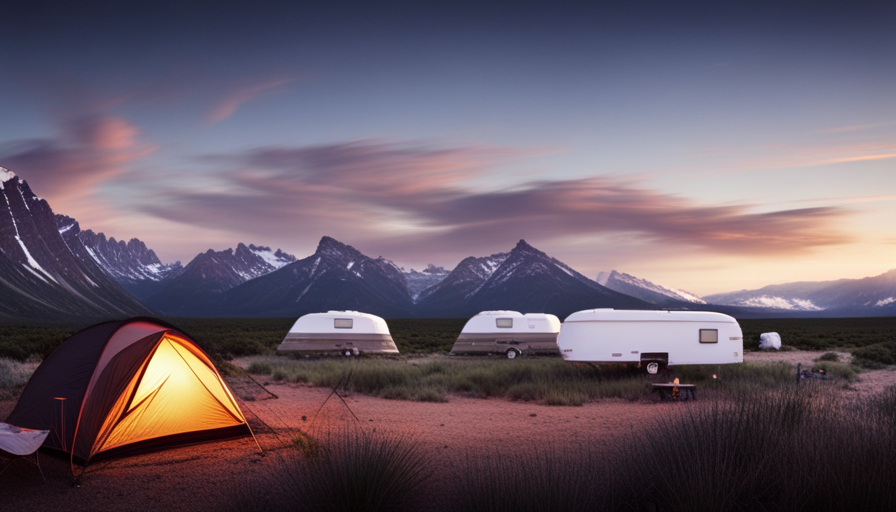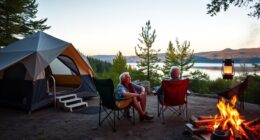Are you prepared for an adventurous camping excursion? Picture this scenario: a cool autumn night, you are cozy in your camper. Suddenly, the temperature drops inside significantly. You begin to panic, wondering, “How can I heat up this space?” Fear not, fellow campers, I am here to help. I will demonstrate how to ignite a propane furnace so you can remain warm throughout the entire night.
In this detailed and informative article, I will walk you through each step of the process, ensuring your safety and comfort throughout. From understanding the safety precautions to practicing regular maintenance, you’ll learn everything you need to know to keep your camper warm and toasty.
So, grab your tools, locate the furnace, and get ready to embark on a journey of warmth and relaxation. Let’s dive in and discover the secrets of lighting a propane furnace in a camper.
Key Takeaways
- Understanding safety precautions is crucial when lighting a propane furnace in a camper.
- Gathering the necessary tools and supplies, such as a propane tank and an ignition source, is important for the process.
- Lighting the pilot light correctly is essential, and troubleshooting potential issues is necessary.
- Regular maintenance and inspection of the furnace are crucial for efficient and safe operation.
Understand the Safety Precautions
Before you even think about lighting the propane furnace in your camper, you need to fully understand and prioritize the safety precautions. It’s crucial to understand the risks associated with handling propane and the potential dangers that can arise if not handled properly.
The first step in ensuring your safety is to carefully read and follow the manufacturer’s instructions. These instructions will provide you with important information on how to properly operate and maintain the propane furnace. They’ll also outline any specific safety precautions that need to be taken.
One of the most important safety precautions is to ensure proper ventilation when using the propane furnace. This is because propane produces carbon monoxide, a colorless and odorless gas that can be deadly if inhaled in high concentrations. Make sure that the area where the furnace is located is well-ventilated to prevent the buildup of carbon monoxide.
Another safety precaution is to regularly inspect the propane furnace for any signs of damage or leaks. Look for any cracks, rust, or loose connections. If you notice any issues, it’s important to address them immediately to prevent any potential accidents or malfunctions.
Understanding and following these safety precautions is essential before attempting to light your propane furnace. Once you have a good grasp of the safety measures, you can move on to gathering the necessary tools and supplies to successfully light your furnace.
Gather the Necessary Tools and Supplies
First, make sure you have all the essential tools and supplies needed to ignite warmth and coziness in your mobile sanctuary. When it comes to lighting a propane furnace in your camper, it’s crucial to have the right camping essentials and prioritize propane safety. Here are three items you’ll need to get started:
-
Propane tank: Ensure you have a filled propane tank before attempting to light the furnace. It’s important to check the tank for any leaks or damage beforehand.
-
Igniter or long lighter: To safely ignite the propane furnace, you’ll need an igniter or a long lighter specifically designed for this purpose. This will help you reach the pilot light without putting your hand in harm’s way.
-
Flashlight: A flashlight is an essential tool for any camper. It will come in handy when locating the furnace and accessing the control panel, especially if you’re in a dimly lit area.
Now that you have all the necessary tools and supplies, it’s time to locate the furnace and access panel. This step will allow you to safely and efficiently light the propane furnace in your camper.
Locate the Furnace and Access Panel
To start the process, find the cozy heart of your mobile sanctuary by locating the furnace and access panel. The furnace is typically located in a central area of the camper, such as under a bed or in a closet. Once you have located the furnace, you will need to access the panel to perform any necessary maintenance or troubleshooting.
To help you better understand the furnace and access panel, here is a table that provides a detailed overview:
| Furnace Components | Access Panel Location | Common Furnace Problems |
|---|---|---|
| Burner Assembly | Inside the furnace | Ignition failure |
| Blower Motor | Inside the furnace | Motor not running |
| Control Board | Inside the furnace | Faulty thermostat |
Now that you know where the furnace and access panel are located, you can proceed with troubleshooting any common furnace problems. It is important to familiarize yourself with these common issues to ensure proper functioning of your propane furnace.
Next, we will learn how to turn off the gas supply to the furnace.
Turn off the Gas Supply
To ensure your safety, it’s crucial to shut off the gas supply before working on the furnace.
Before attempting to light the propane furnace in your camper, locate the gas valve that connects the propane tank to the furnace. This valve is typically located near the furnace or within the access panel. To turn off the gas supply, simply rotate the valve to the closed position. This action will prevent any gas from flowing to the furnace, reducing the risk of accidental ignition or gas leaks.
Once the gas supply has been shut off, you can proceed to the next step of preparing the ignition source. This may involve lighting the pilot light or using an electronic ignition system, depending on the specific furnace model.
By following these safety precautions and properly shutting off the gas supply, you can ensure a safe and successful ignition process for your propane furnace.
Now that the gas supply has been secured, let’s move on to preparing the ignition source for the next step.
Prepare the Ignition Source
Now that you’ve secured the gas supply, it’s time to get the ignition source ready. When it comes to lighting a propane furnace in a camper, there are a few ignition source options available. The most common ones include a match, a lighter, or an electronic ignition system. Whichever method you choose, it’s important to ensure you have the necessary safety equipment on hand before proceeding.
To help you choose the right ignition source, refer to the table below:
| Ignition Source Options | Pros | Cons |
|---|---|---|
| Match | Easy to use | Can be blown out by wind |
| Lighter | Convenient | Limited reach |
| Electronic Ignition | Reliable | Requires batteries |
Once you’ve decided on the ignition source, gather the appropriate safety equipment, such as gloves, safety glasses, and a fire extinguisher. These precautions will help protect you in case of any accidents during the lighting process.
With the ignition source prepared and safety measures in place, you’re now ready to move on to the next step: lighting the pilot light. This will ensure the propane furnace in your camper starts up safely and efficiently.
Light the Pilot Light
Once you’ve ensured your safety equipment is in place, it’s time to ignite the pilot light and get your cozy home on wheels nice and warm.
Before you begin, it’s important to troubleshoot any potential issues with the pilot light. Make sure the propane tanks are full and turned on, and check that the furnace is properly connected to the propane supply. If you’re still having trouble, consult the manufacturer’s manual for specific troubleshooting steps.
To light the pilot light, locate the pilot light assembly. It is typically found near the burner assembly inside the furnace. Turn the gas control knob to the ‘pilot’ position and press it down. This will allow gas to flow to the pilot. While holding down the gas control knob, use a long-reach lighter or a fireplace match to ignite the pilot light.
Once the pilot light is lit, continue holding down the gas control knob for about 30 seconds to allow the thermocouple to heat up.
After the 30-second countdown, release the gas control knob, but don’t let go completely. Instead, continue to hold it down for another minute. This is necessary to ensure that the pilot light stays lit. After one minute, you can release the gas control knob and the pilot light should stay lit.
Now, you’re ready to move on to the next step: holding the pilot light button to start the furnace.
Hold the Pilot Light Button
After successfully igniting the pilot light, it’s time to give that cozy home on wheels a warm embrace by holding down the pilot light button. This is a crucial step in ensuring that the propane furnace stays lit and continues to provide heat. By holding down the button, you’re allowing the flow of propane to the burner, which keeps the flame alive.
It’s important to note that the pilot light button should be held down for a few seconds to ensure that the flame is stable before releasing it. This will prevent the flame from going out and the need to relight it. If the flame goes out immediately after releasing the button, it could mean that there’s a problem with the ignition source or the propane supply.
If you encounter any issues with the pilot light going out or not staying lit, there are a few troubleshooting steps you can take. Firstly, check for any obstructions in the burner or pilot light assembly, such as dirt or debris. Clean them if necessary. Secondly, ensure that the propane supply is sufficient and not running low. Lastly, consider using alternative ignition sources, such as a long-reach lighter or a match, to start the furnace if the built-in ignition system isn’t working properly.
With the pilot light successfully held down, it’s time to move on to the next step: adjusting the thermostat.
Adjust the Thermostat
As you cozy up in your home on wheels, let the thermostat be the conductor of warmth, orchestrating the perfect temperature for your comfort. Proper calibration of the thermostat is crucial to ensure accurate temperature control. Here are four steps to help you adjust the thermostat in your propane furnace in a camper:
-
Locate the thermostat: The thermostat is usually mounted on the wall and connected to the furnace. It’s essential to know its exact position for easy access.
-
Check the calibration: Use a thermometer to compare the temperature displayed on the thermostat with the actual temperature in the camper. If there’s a significant difference, the thermostat may need calibration.
-
Adjust the calibration: Consult the manufacturer’s instructions to calibrate the thermostat. Usually, this involves removing the thermostat cover and adjusting a small screw or dial to align the displayed temperature with the actual temperature.
-
Troubleshooting tips: If the thermostat isn’t functioning correctly, check the battery or power source, clean the contacts, and ensure there are no obstructions affecting its operation.
By following these steps, you can ensure that your thermostat is accurately calibrated for optimal temperature control in your camper. Now, let’s move on to the next section and learn how to monitor the furnace operation.
Monitor the Furnace Operation
Keep a close eye on how your cozy home heats up, ensuring your comfort and peace of mind. Monitoring the furnace operation is crucial to maintain its efficiency and prevent any potential issues.
One important aspect to monitor is the fuel consumption. Regularly check the propane levels to ensure that you have an adequate supply for the furnace to operate smoothly. If you notice a sudden increase in fuel consumption, it could indicate a problem with the furnace, such as a clogged burner or a faulty thermostat. Troubleshooting these common furnace issues promptly can save you from costly repairs and discomfort in the long run.
Another important aspect of monitoring the furnace operation is to be aware of any unusual noises or smells. If you hear strange noises coming from the furnace, it could indicate a problem with the blower motor or the fan. Similarly, if you detect a strong odor of gas, it’s crucial to turn off the furnace immediately and seek professional help, as it could be a sign of a gas leak.
Monitoring the furnace operation is essential for maintaining a safe and efficient heating system in your camper. By keeping an eye on fuel consumption and promptly troubleshooting any issues, you can ensure your comfort and peace of mind.
Now, let’s transition into the subsequent section about practicing regular maintenance and inspection to further enhance the performance of your propane furnace.
Practice Regular Maintenance and Inspection
Now that we’ve discussed the importance of monitoring the furnace operation in your camper, let’s move on to the next crucial step in ensuring its efficient functioning: practicing regular maintenance and inspection.
Regular maintenance is essential to keep your propane furnace running smoothly and efficiently. It helps identify any potential issues before they become major problems, ensuring that your furnace operates reliably when you need it the most.
One of the first things you should do is clean or replace the furnace filter. This helps maintain proper airflow and prevents dust and debris from clogging the system.
Inspecting the furnace regularly is equally important. Check for any signs of wear and tear, such as loose connections, cracks in the heat exchanger, or damaged wiring. Ensure that the venting system is clear of any obstructions and that the exhaust is properly vented outside.
Additionally, it’s crucial to inspect and clean the burner assembly and the blower motor. Remove any accumulated dirt or debris that may hinder their performance.
Remember, regular maintenance and inspection are key to maximizing the lifespan of your propane furnace and preventing costly repairs. By taking the time to perform these tasks, you can have peace of mind knowing that your camper’s furnace will keep you warm and comfortable during your adventures.
Frequently Asked Questions
How often should the propane furnace in a camper be inspected?
Propane furnace maintenance is crucial for safety. Regular inspections are recommended to ensure proper functioning and identify any potential issues. Safety precautions should be followed during inspections, such as turning off the propane supply and allowing the furnace to cool down.
It’s advised to consult the manufacturer’s guidelines for specific maintenance intervals. By prioritizing propane furnace maintenance, you can enjoy a safe and reliable heating system during your camping adventures.
Can I use a regular lighter or match to ignite the pilot light?
Yes, it’s possible to use a regular lighter or match to ignite the pilot light of a propane furnace in a camper. However, it’s important to take certain safety precautions while doing so. Ensure that the area around the furnace is clear of any flammable materials and make sure to hold the lighter or match securely. Keep your face and hands away from the furnace while igniting the pilot light to avoid any accidents.
Is it necessary to turn off the gas supply every time the furnace is not in use?
It’s not necessary to turn off the gas supply every time the furnace isn’t in use. However, there are pros and cons to consider when using a propane furnace in a camper.
On the positive side, propane furnaces provide efficient heating and are convenient to use.
On the downside, they require regular maintenance to ensure safe and optimal performance. Tips for maintaining a propane furnace in a camper include regular inspections, cleaning, and checking for any gas leaks.
Can I adjust the temperature on the thermostat while the furnace is running?
Yes, you can adjust the temperature on the thermostat while the furnace is running. It’s important to note that the thermostat controls the temperature settings, while the furnace itself regulates the heat output.
If you’re experiencing any issues with adjusting the thermostat settings or if the temperature is not changing as expected, it could be due to common thermostat issues like a faulty sensor or wiring problems. Troubleshooting these problems will help you get your thermostat working properly.
Remember, as the saying goes, "A well-adjusted thermostat keeps the comfort flowing."
What are some common signs of a malfunctioning propane furnace in a camper?
Common signs of a malfunctioning propane furnace in a camper include a lack of heat output, inconsistent heating, strange noises during operation, and a strong smell of propane.
Additionally, if the furnace fails to ignite or constantly shuts off, it may indicate a problem. It’s important to address these issues promptly to ensure the safety and comfort of the occupants.
Regular maintenance and professional inspections can help prevent and identify furnace malfunctions.
Are the Steps to Light a Pilot Light on a Camper Furnace Similar to Lighting a Propane Furnace?
The steps to light a pilot light on a camper furnace are similar to lighting a propane furnace. To ignite the light pilot light, ensure the gas supply is on, locate the pilot valve, switch it to pilot, and press the control knob while using a long-reach lighter to ignite the flame. Once lit, hold the knob for a minute, then release it and set the thermostat to desired temperature.
Are Propane Furnaces the Most Effective Way to Heat a Camper?
Propane furnaces are often considered the most effective way of turning heat on campers. They are efficient, reliable, and can provide a consistent source of warmth, making them a popular choice for campers. With proper maintenance, propane furnaces can keep your camper cozy even in the coldest of weather.
Conclusion
Well, now you know how to light a propane furnace in a camper. It’s a skill that could come in handy, especially on those chilly camping trips. Just remember to follow all the safety precautions, gather the necessary tools, and locate the furnace and access panel.
Oh, and don’t forget to turn off the gas supply before you start. With a little practice, you’ll be able to adjust the thermostat and monitor the furnace operation like a pro. And of course, don’t forget to regularly maintain and inspect your furnace.
Happy camping!

